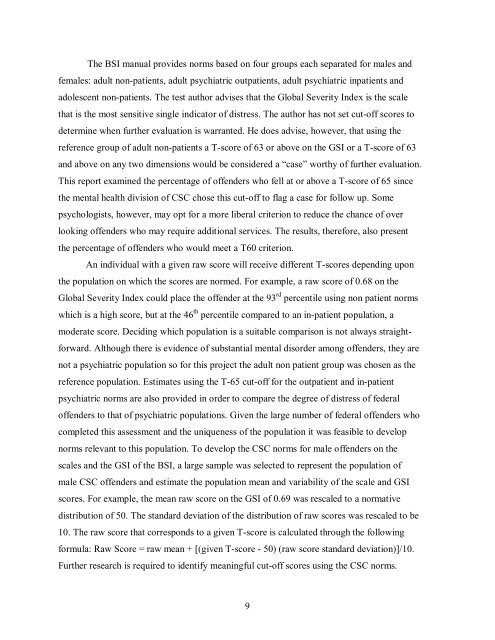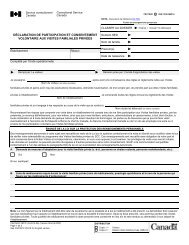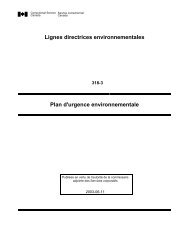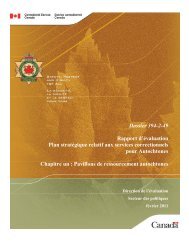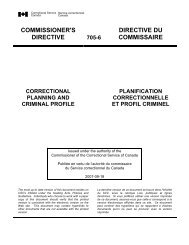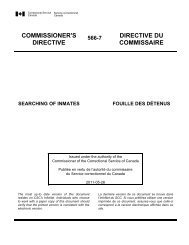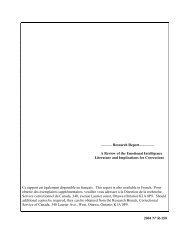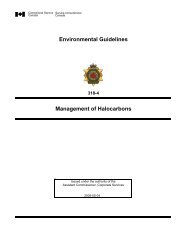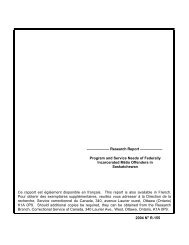The Brief Symptom Inventory (BSI) - Service correctionnel du Canada
The Brief Symptom Inventory (BSI) - Service correctionnel du Canada
The Brief Symptom Inventory (BSI) - Service correctionnel du Canada
Create successful ePaper yourself
Turn your PDF publications into a flip-book with our unique Google optimized e-Paper software.
<strong>The</strong> <strong>BSI</strong> manual provides norms based on four groups each separated for males and<br />
females: a<strong>du</strong>lt non-patients, a<strong>du</strong>lt psychiatric outpatients, a<strong>du</strong>lt psychiatric inpatients and<br />
adolescent non-patients. <strong>The</strong> test author advises that the Global Severity Index is the scale<br />
that is the most sensitive single indicator of distress. <strong>The</strong> author has not set cut-off scores to<br />
determine when further evaluation is warranted. He does advise, however, that using the<br />
reference group of a<strong>du</strong>lt non-patients a T-score of 63 or above on the GSI or a T-score of 63<br />
and above on any two dimensions would be considered a “case” worthy of further evaluation.<br />
This report examined the percentage of offenders who fell at or above a T-score of 65 since<br />
the mental health division of CSC chose this cut-off to flag a case for follow up. Some<br />
psychologists, however, may opt for a more liberal criterion to re<strong>du</strong>ce the chance of over<br />
looking offenders who may require additional services. <strong>The</strong> results, therefore, also present<br />
the percentage of offenders who would meet a T60 criterion.<br />
An indivi<strong>du</strong>al with a given raw score will receive different T-scores depending upon<br />
the population on which the scores are normed. For example, a raw score of 0.68 on the<br />
Global Severity Index could place the offender at the 93 rd percentile using non patient norms<br />
which is a high score, but at the 46 th percentile compared to an in-patient population, a<br />
moderate score. Deciding which population is a suitable comparison is not always straight-<br />
forward. Although there is evidence of substantial mental disorder among offenders, they are<br />
not a psychiatric population so for this project the a<strong>du</strong>lt non patient group was chosen as the<br />
reference population. Estimates using the T-65 cut-off for the outpatient and in-patient<br />
psychiatric norms are also provided in order to compare the degree of distress of federal<br />
offenders to that of psychiatric populations. Given the large number of federal offenders who<br />
completed this assessment and the uniqueness of the population it was feasible to develop<br />
norms relevant to this population. To develop the CSC norms for male offenders on the<br />
scales and the GSI of the <strong>BSI</strong>, a large sample was selected to represent the population of<br />
male CSC offenders and estimate the population mean and variability of the scale and GSI<br />
scores. For example, the mean raw score on the GSI of 0.69 was rescaled to a normative<br />
distribution of 50. <strong>The</strong> standard deviation of the distribution of raw scores was rescaled to be<br />
10. <strong>The</strong> raw score that corresponds to a given T-score is calculated through the following<br />
formula: Raw Score = raw mean + [(given T-score - 50) (raw score standard deviation)]/10.<br />
Further research is required to identify meaningful cut-off scores using the CSC norms.<br />
9


